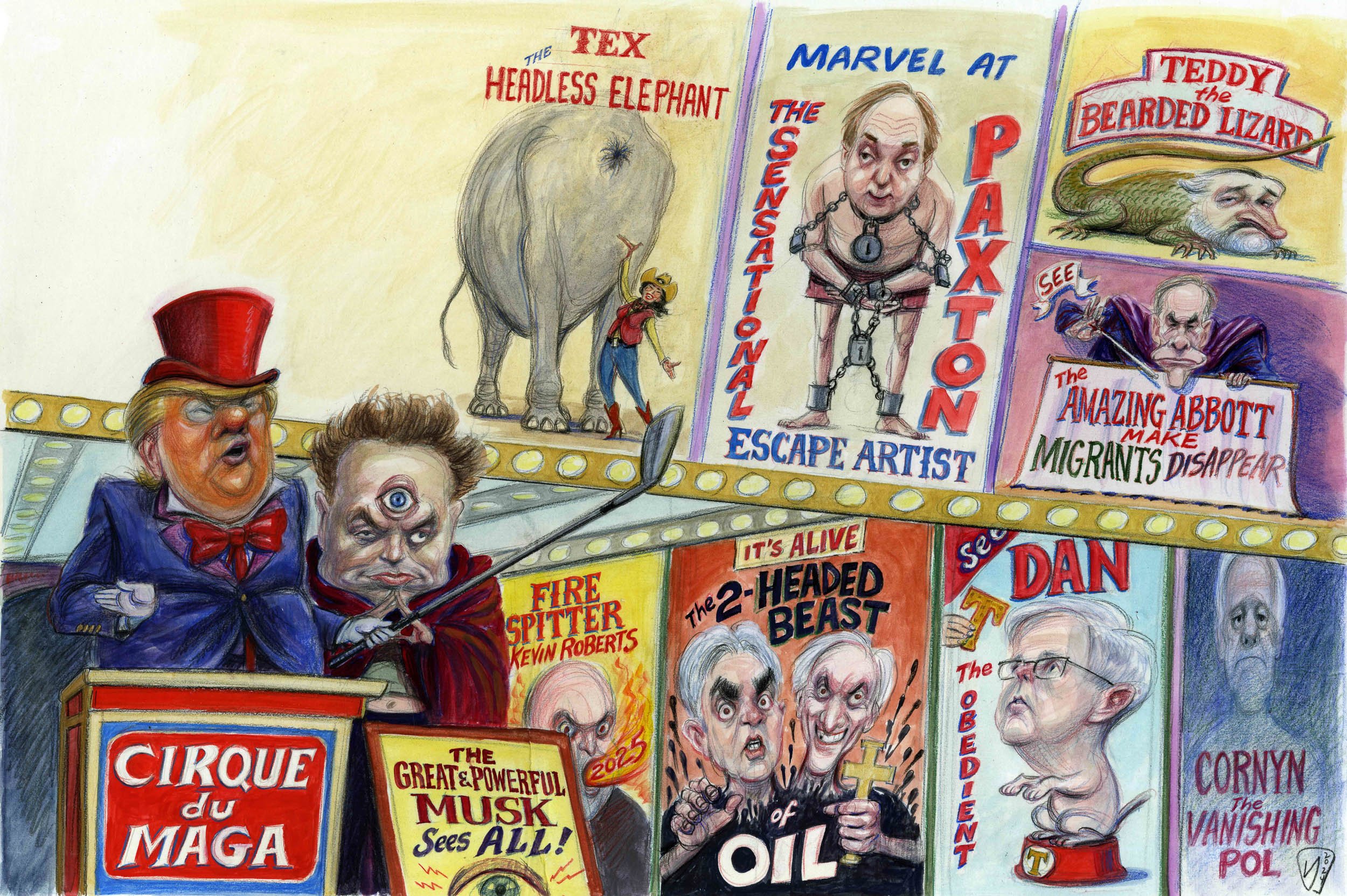Prairie Renaissance
After so many years away from Abilene, I had almost begun to believe that the stories I told about my hometown were the only stories there were to tell: my elementary school teacher who convinced 30 fourth-grade students that the Soviet Union had taken over the U.S. earlier that morning, causing half of us to burst into tears—a lesson meant to help us appreciate our freedom. The biology teacher who kept a picture of an aborted fetus on his office door. The time in high school when fellow students scrawled “Vegetarians Have Sex with Animals” in big letters on our driveway.
In my mind, the city was immutable: my Bible Belt, backwater hometown.
But even then, Abilene had a lovely, eccentric side. I remember the first time I walked into the downtown studio of our local art celebrity, Clint Hamilton, and was shocked that such a magical spot could inhabit this conservative, Protestant place. Hamilton had lived for years in New York and worked among the biggest names in Pop Art—there were several early Andy Warhols on his wall, one inscribed, “Happy Birthday, Clint.” He didn’t just make collages (or assemblages, as he would say, using the French pronunciation), his studio was one: Art and photos covered every inch of wall, bits of glittery paper or cut metal hung from the ceiling, surfaces were strewn with small objects collected from junk shops.
But despite my love of his curio-filled studio, I wasn’t particularly impressed by Clint himself. To a girl whose primary ambition was to see Abilene fade away in the rearview mirror, I couldn’t fathom why anyone in the Manhattan art scene would willingly return to Abilene. I decided Clint was a failure. But the story of Clint Hamilton, and the art scene in Abilene, was more complex than a cocky teenager understood.
Clint Hamilton graduated from Abilene High in 1947. By all accounts, his talent was apparent early on. He won scholarships to study art and created window displays for Sanger department stores in Dallas and, after moving to NYC in his early 20s, for Bonwit Teller and Tiffany & Co., where he presented pieces by other struggling artists as part of his creations. Andy Warhol’s first exhibit was in a Clint Hamilton window display on Fifth Avenue—unveiled for the first time, like all big windows back then, at 5 p.m., just as Manhattanites began walking home from work. In an interview for the Abilene Reporter-News, Hamilton said, “I was living in a garret on 10th and Hudson, and I got greatly hungry. I found I could make a living in window display.”
After 16 years of breaking down barriers between high and low art in the emerging Pop Art scene, Clint Hamilton returned home in 1967 and moved in with his parents. It’s not easy to get folks in Abilene to talk about why Clint moved home, back to his roots and his family. The official biographies attribute his flight to illness. A photographer friend of his said he was “overstimulated” by the New York scene. The truth is, Clint struggled with inner demons, including alcoholism and his closeted homosexuality. Letters written to him over many years from his friends and intimates hint at how fraught with mixed emotions this choice of self-exile must have been.
It might seem strange that Clint went back to live with his folks, but they were clearly kindred spirits. His parents were pack rats and collectors of clutter; playbills and earrings and arrowheads were stacked in every nook and cranny. There was hardly a place to sit, much less walk. The Hamiltons would let you take something you needed for a project as long as you promised never to bring it back. When Clint died, the theater department of one local university received 25 Hawaiian shirts and a real phone booth from this house of treasures.
But there are benefits to a small town, and despite living in mystical squalor with his parents, Clint was a star in Abilene. Known as the Archduke of Art, he became the unofficial mascot for the local art community. Dozens of people around town considered him their best friend in the world. He was an entertainer—always quick with a groan-inducing pun—and loved to make fun of his odd appearance by exaggerating it, walking around the Center for Contemporary Arts in elf shoes, a Cyrano de Bergerac nose and palmetto fans behind his ears.
The pieces he created in Abilene were often playful, including one collage titled “Escargogo,” featuring a series of doll legs in a kick line topped by seashells. He created a Francophile manger scene with the star of Bethlehem sitting atop a model of the Eiffel Tower, porcelain dogs playing instruments, and a red frog. Clint would poke fun at how the bourgeoisie collected art in the titles of some of his assemblages (“You Said You Wanted a Fish Above Your Bed,”), but in general Clint’s persona was warm, not pretentious. When he was in the hospital toward the end of his life, one nurse said she’d heard he used to work for Tiffany’s and that she’d always wanted to eat breakfast there. Clint told her he thought she would enjoy it.
Clint Hamilton was also perpetually strapped for cash, so he would curate exhibits for museums and galleries in the area, and he would create displays for debutante balls, theater openings and society Christmas parties. His centerpieces often rivaled the events themselves. His favorite trope was the headdress, and he put elegant, glittery tinsel ones on mannequins for department–store window displays. For the Paramount Theater, he made an assemblage headdress from cut-out photos of stars like Garbo and Valentino and lit-up marquees. For one particularly adventurous patron, he made a hot pink straw hat with purple net bows and hen eggs. He said, “Nobody can ever begin to imagine the work which went into creating, bit by bit, each of the headdresses, each of the decorative units.”
He didn’t consider these projects beneath him but rather their own kind of art, one that involved the community in a way that museums and galleries couldn’t. In an interview, he snorted with disdain at the thought that “some people will walk by the windows and think that things were just stuck there, any which way, by chance.” As Judy Deaton, art historian and curator of exhibits at Abilene’s Grace Museum, argued, Clint made art seem welcoming and accessible to average people because “he didn’t see it as an elite, intellectual process.” Or as Lynn Barnett, director of Abilene’s Cultural Affairs Council, told me, with Clint, people had a chance to see how art happens. He would pick up a piece of junk at your garage sale, and “the next week it would look magnificent in a display or in his next work of art.”
Maybe because of his roots in Pop Art or his window-dressing past, Hamilton didn’t seem to worry about the permanence of his creations. Deaton said that he would take collages apart and remake them, paint over them, and thread them with organic materials. Clint gave a wonderful piece to friends of my parents after they had starred in a production of Who’s Afraid of Virginia Woolf? It’s a woodblock print of Woolf herself surrounded by beads and pencil marks and delicate insect wings, pieces of which had disintegrated over time and collected in the bottom of the frame like fairy dust.
While much of Clint’s tangible work is scattered or falling apart, his real legacy may be the Abilene art scene. Before his death in 2001, Clint taught art to hundreds of kids and adults in Abilene, mentoring a string of young artists and gallery curators who came through the budding art scene. Hardly the failure I’d once thought him to be, Clint ultimately made more of an impact here than he could have in New York. He was the first director of the Center for Contemporary Arts, a cooperative that still holds monthly art walks that bring more than 500 people to museums, shops and galleries in Abilene’s once-deserted downtown.
Clint was not alone in these efforts. Officials realized early on the potential for the arts as an economic driving force, so they used the city’s tourist tax to create and support a Cultural Affairs Council with a professional staff. Wealthy local philanthropists have chipped in to support artists and museums. Thanks to these efforts, the boarded-up Drake Hotel, built in 1909 in the Mission Revival style and fallen into disrepair over the years, blossomed into the stunning Grace Museum with world-class exhibits. Across the street, the old railroad right-of-way has been landscaped and now sprouts outdoor sculptures.
This year the Texas Commission for the Arts named Abilene one of five designated “cultural districts” in the state, a program that highlights cities with thriving art scenes. When I heard that news, I was surprised. And then I wasn’t. Abilene was not just my Bible Belt, backwater hometown. Like the collages and windows of Clint Hamilton, cities revive and fall away and transform into something different. In Abilene, Clint saw the raw materials for art.
On a recent trip back to town, I attended the senior art show of Hannah Capra, Clint’s last student, who plans to go to art school in New York in the fall. A willowy young woman with long black hair, her work was both glossy and dark, butterflies and gas masks. At one end of the hallway hung a crayon portrait she drew of Clint when she was 6. He was in poor health by this time, and she drew the lines of oxygen coming out of his nose like tentacles. She said walking into his house was like walking into a dream, a broken bottle from the street standing next to a fine vase. He would turn to her and say, “Make something.”
Afterward, I stopped by the hip new coffee shop across the street from where Clint’s studio used to be. It sells T-shirts with slogans like “Keep Abilene Boring” or “What Happens in Abilene, Leaves Abilene.” Pretty much my sentiments when living there as a young person. Drinking my Fair Trade coffee, I remembered what Hannah told me about a piece Clint did, made up of pennies with tiny vintage photographs on them, and how they made her “see pennies for the first time.” That was a little bit how I felt now, like seeing my own Abilene in an entirely new light.
Mary Helen Specht lives in Austin. Her fiction and nonfiction has appeared in numerous publications, including The New York Times. Her website is maryhelenspecht.com.


